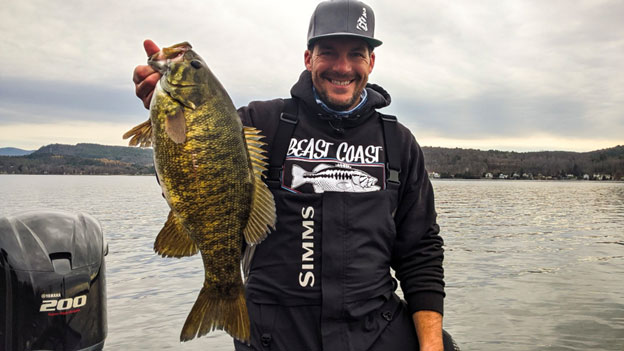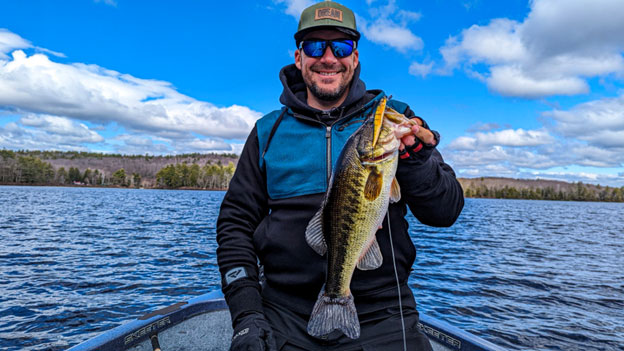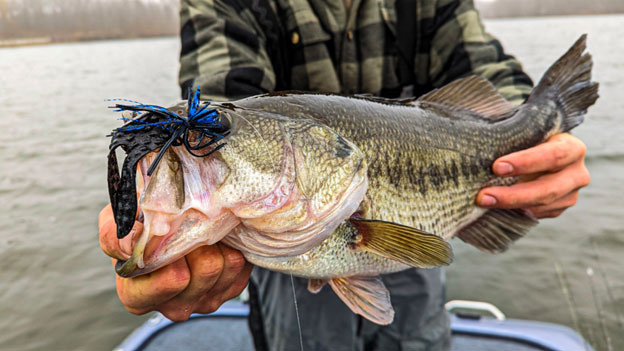Author: Sean Snover

For those that live in the northern half of the United States and well up into Canada, bass fishing in cold water is a necessity if one wants to extend the season as long as possible. For those that are beyond obsessed with bass fishing like me, it’s not just a necessity, it’s a way of life. Living in southern New Hampshire, four to five months of my year is spent fishing in cold water, where surface water temperature is 45 degrees or colder. While it isn’t easy, I fully embrace the challenge that it represents because I know that it will make me a better angler. Most anyone can catch bass when the water temperature climbs into the 50’s and higher. But it takes patience, time, and sometimes more desire than sense to be consistently successful – for the most part – when you are bass fishing through the winter months. My goal with this article is to share the information I have gained and perfected over the years to help you become better at cold water bass fishing more quickly than you would be going into it blind.
If I had to boil all the information, tips, and insight I’ve learned over the years down to one major point, it would be this: go as slow as you can, and once you think you’re going slow enough, go slower. The most common aspect of my success with cold water bass fishing is my ability to be comfortable fishing uncomfortably slow on a regular basis. While there are some days that the bite is much hotter than the air temperature, often it’s the opposite, and I find myself fishing at a snail’s pace to get bites. For some, it may take a lot of time and fish-less days to achieve comfort and confidence fishing glacially slow, but I promise you that the reward is worth the effort. Enough of the overindulgence in the fancy talk, let’s get to the good stuff and talk techniques. Baits. Lures. The things I utilize to catch these pesky greenheads and bronzebacks alike.
I use a wide variety of techniques and lures to catch bass in cold water. The three most consistently successful are: jigs; jerkbaits; and bladed jigs. Now, a lot of these come down to personal preference in what I enjoy using most compared to other techniques, so that is not to say that these are the best choices. They are just a suggestion – albeit a strong suggestion – backed by years of consistent success using them all over the northeast, throughout the entirety of winter.

My first choice for cold water bass fishing will always be a jig. I prefer a finesse football jig like the OW Sniper from Beast Coast Fishing in MB Pumpkin, or the Hustler Hybrid Finesse Jig which is also from Beast Coast Fishing, in their Dirt Bag or Bruised colors. For the OW Sniper jig, it earned its keep as my go-to jig because of its unique combination of features. It has a lower than normal 22 strand skirt that is cut to be shorter than a traditional jig, a stout 2/0 BKK hook capable of withstanding the abuse of over 100 angry pre-spawn smallmouth bass on Lake Champlain in a single day, and no brush guard. When paired with a small swimbait or craw type trailer, it becomes subtly bulky, which I find bass prefer often in cold water. Small enough to be easy pickings for them, but big enough to be a meal that warrants the energy expenditure to swim for. On days that I can’t get a bite on this jig, I downsize to the ¼ oz Hustler Hybrid Finesse jig as it provides an even smaller profile, and it has the added benefit of marabou hair to make it more tantalizingly desirable. For me, fishing a football jig is the easiest bait to fish slowly for three reasons. Primarily, the football shaped jig head does a phenomenal job of standing up, presenting your trailer as an easy to find target. Secondly, there’s no guess work as to what the jig is doing. I don’t have to worry or wonder about it like a suspended jerkbait, it just sits on the bottom, waiting to be eaten. Lastly, with a tungsten jig I can feel the bottom composition much more easily, so I know exactly what I’m working the jig through, whether it’s sand, mud, or rocks. Knowing what kind of structure, you are dragging your jig through before you catch a fish greatly helps you to understand the successful pattern for that particular day.
For the OW Sniper in 3/8 oz or ½ oz, I prefer a casting setup, using the Douglas Outdoors XMATRIX DXC 715F casting rod paired with a high gear ratio real and 11.6-15.5 lb Defiant Fishing Heavy Cover fluorocarbon. The DXC 715F to me is like the ultimate boxer, light on their feet but packs a mean uppercut. The fast action has the perfect deflection point that I can cast the lighter 3/8 oz jig a long distance, or sidearm cast a ½ oz jig low with pinpoint accuracy to a spot very close to the boat. But it also has the power that I can confidently set the hook on a fish at the end of a 200-foot cast that’s in 50 feet of water, even with straight fluorocarbon, and keep that fish pinned. It has the perfect balance of finesse and power that I look for in a jig rod that is perfect for year-round fishing, not just the cold-water months.
When it comes to the Hustler Hybrid Finesse jig, I tend to throw the ¼ oz more often than the 3/8 oz, and the Douglas Outdoors XMATRIX DXS 724XF spinning rod is perfect for throwing both. I like this rod for all the same reasons I like the DXC 715F. It’s supple enough to drop this small jig on a dime when I see the perfect boulder at the break of a steep bank, but strong enough to pin and hold big fish from down deep on the longest casts. I will always opt for a braid to leader combination for my spinning setup, starting with Defiant Fishing’s 18 lb. Smooth Casting braid to a 10-15 ft. long leader of Defiant Fishing’s 9.2-11.6 lb. Heavy Cover fluorocarbon.
As much as I love throwing a jig, in my opinion the undisputed champion for cold water is the jerkbait. To be as effective as possible in your cold-water bass fishing endeavors, you really need to be comfortable and confident in fishing suspended jerkbait because of how consistently effective they are. Their ability to stay in place at a specific depth for an extended period is what makes them such excellent fish catchers. This is important for cold water bass as they are not always interested in expending a lot of energy on their meal. If your water temperature is still holding strong in the 30’s, then the bass will still be more lethargic, moving slowly, eventually nosing up to your bait before deciding if they will eat it or not. The subtle but erratic action of the jerkbait will get their attention, but its ability to stay perfectly still – or nearly so – is what ultimately helps you to catch these fish. Presenting itself as a struggling bait fish, it looks like an easy and hearty meal that more of than not, bass just can’t resist. My favorite jerkbait is the Megabass Vision OneTen because I never have to second guess if it’s going to suspend. Without fail, they have worked perfectly as they are right out of the box every time, and their color selections are second to none. Lastly, my go-to color choices for cold water bass fishing are the GP Pro Perch and the GP Pro Blue 2. There’s something about a darker blue jerkbait that always works in cold, stained water. And with perch being highly active in cold water as they are spring spawners, it’s an easy choice to mimic for their main forage.

Douglas Outdoors offers several different rods that excel at throwing jerkbaits, whether it’s something smaller like the 3/8 oz. Megabass Vision OneTen Jr., or the bigger and heavier ½ oz. Megabass Vision OneTen+2. For my smaller and lighter jerkbaits, I will reach for the XMATRIX DXC 684F or the similar LRS C684F. I find that I have more control with this rod on lighter jerkbaits, especially if you’re dealing with a moderate amount of wind at most. The power and action lend itself to be ideally suited for a lighter bait. For the bigger and heavier jerkbaits, I opt for the XMATRIX DXC 704M or the similar LRS C704M. This model has a little bit more backbone for good, controlled casts with a heavier bait, but the moderate action has enough give to it that you’re not going to rip the smaller & thinner hooks free if you’re a little overzealous on your hook set. I keep it very simple with the reel & line choice on jerkbait setups, opting for a 6.3:1 gear ratio reel paired with Defiant Fishing’s Soft Casting 9.2 lb. fluorocarbon.
When the weather is in your favor on the day you finally get out on the water, and you’re finding the fish a little shallower or at least in a more active mood, a bladed jig is hard to beat. There’s a myriad variety of bladed jigs on the market, and they all have their pros and cons. For cold water bass fishing, the Z-man Evergreen Chatterbait Jack Hammer has been my top choice since it was released, for the primary reason that it starts vibrating very fast and with very little effort. This is extremely important in that early season cold water because I can achieve an erratic action out of the bait even when retrieving it very slowly. That matters when the weather is in your favor, and the baitfish and bass have pushed up closer to or on top of the shallow flats with the warmest water. With a 3/8 oz Jack Hammer, I can retrieve it slowly over the top of dead vegetation in shallow water where the bass are waiting to ambush, working in a pause to give them time to commit to the bait, without immediately sinking to the bottom. And after that brief pause, it will start vibrating immediately, continuing to keep the bait at the optimal position for the bass to strike.
There are two different ways to approach your rod choice when fishing a bladed jig. Some anglers prefer a rod like the Douglas Outdoors XMATRIX DXC 745F or the LRS C745F. It’s a slightly more supple rod that has some more give, which some argue can help impart even more action into your bladed jigs. Other anglers, such as I, prefer something with more backbone to really set the hook home on a long hook set and keep those fish pinned. My personal preference is the XMATRIX 746XF or the LRS C746XF for those very reasons. I like throwing a bladed jig on fluorocarbon, and because of that, I want a little more power than usual to ensure I’m getting a solid hook set even at the end of the furthest cast. And I have had plenty of days, even fishing in cold water, where a bass has bit within a few feet of hitting the water on an extra-long cast. There are some give and take with your rod choices for a bladed jig, and it all comes down to personal preference in the end. The easiest solution to decide which of the two is best for you? Buy both! Regardless of the rod choice, like my jerkbait setup, I keep my bladed jig setup very simple. I pair a 6.3:1 gear ratio reel with Defiant Fishing’s 18.4 lb. Heavy Cover Fluorocarbon.

These three techniques and rod suggestions are just one small portion of the incredible options we have for cold water bass fishing. It’s impossible to capture everything without writing an entire book on the subject. Rather than overwhelm anglers looking to dive into the cold-water season, I did my best to keep your potential choices to a minimum, while still providing information backed by many years of consistent success from myself and many other anglers in the northeast. Ultimately, every angler must find what works best for them, and the only way to do that is to spend every opportunity that you have on the water and go through some trial and error. This information will absolutely help to narrow down that search though, and not only maximize your time on the water, but also on your wallet, knowing you’re getting great gear for these applications. I certainly hope you found the information helpful, and I wish you all the best of luck this spring. Dress warmly, use the buddy system, wear your PFD’s, and remember to have fun!